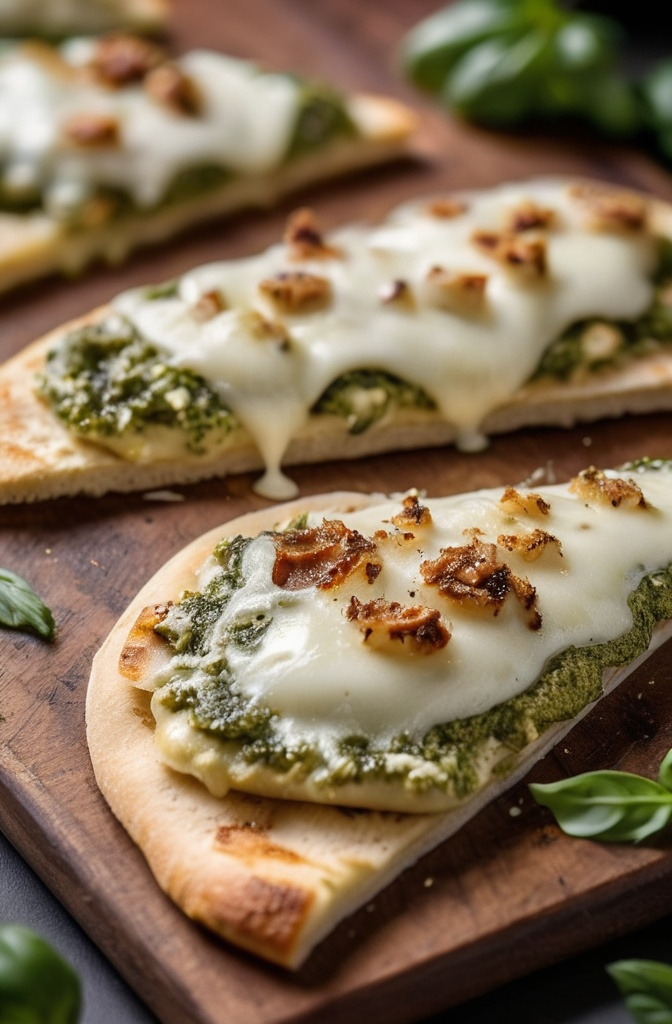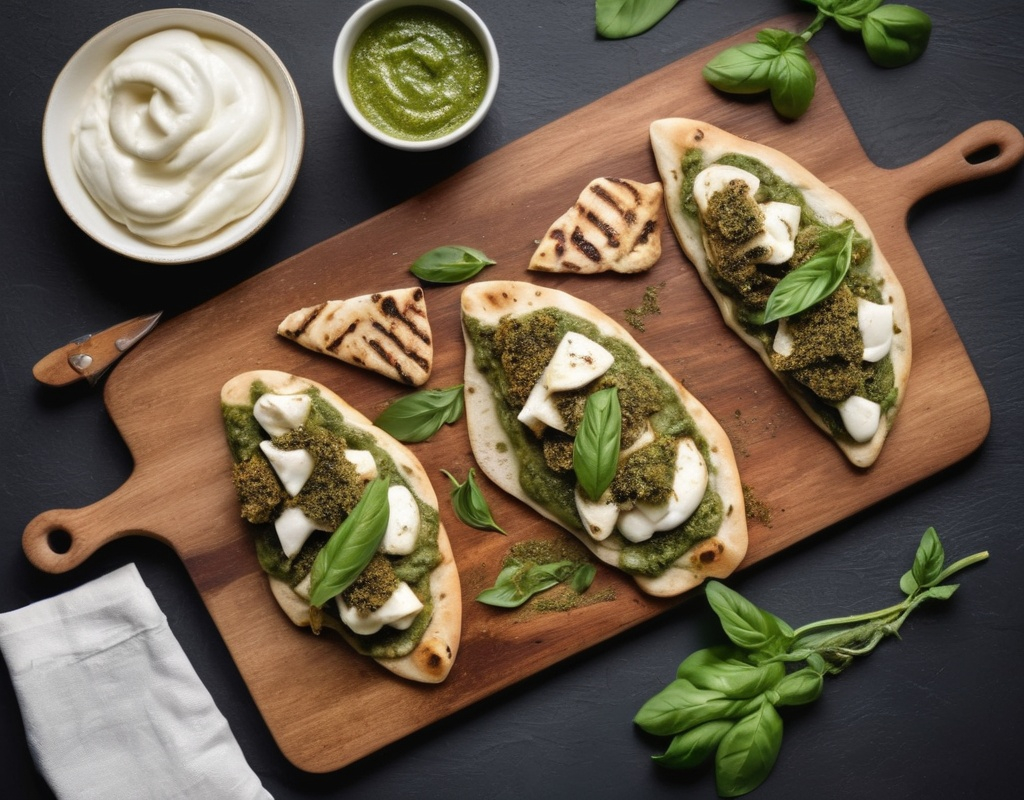There’s flatbread, and then there’s flatbread. The kind that makes a chef stop mid-prep and just… stare at it for a second. That’s what a well-executed pesto chicken and fresh mozzarella flatbread can do. Sounds basic? It isn’t. In the hands of someone who knows how flavor works, how dough lives and breathes, and how mozzarella weeps when it’s perfectly fresh—this dish can punch above its weight in ways that even a high-end entrée might struggle to match.
This article dives deep into how this seemingly simple dish is demanding attention in pro kitchens. We’ll unpack the culinary mechanics, sourcing nuances, and plating psychology that elevate pesto chicken flatbread from casual to craveable. By the end, you’ll know why it deserves a slot on your menu—and not just as a filler.
The Flatbread Foundation: It’s Not Pizza, And It Shouldn’t Try to Be
Flatbread’s charm is its unpretentiousness. But don’t let that fool you—it’s one of the most unforgiving foundations you can work with in a kitchen. There’s nowhere to hide. If your dough’s too thick? Chewy and sad. Too thin? Cracker territory. Not fermented right? Dead flavor.
A proper flatbread dough should be cold-fermented for at least 24 hours. That slow proofing allows enzymes to do their thing, breaking down starches and giving you that subtle tang. Chefs at restaurants like Gjelina in Venice, CA, or Roberta’s in Brooklyn, lean on similar fermentation techniques. Their flatbreads eat like they’ve got a story.
Use a high-gluten flour if you’re aiming for chew, or blend in a bit of cake flour if you want a snap. One trick? Sub a small percentage of flour with semolina—about 5%. You get a bit more character, a tiny bit of grit. Good grit.
Pesto: The Soul of the Dish (If You Do It Right)
Let’s get one thing straight: if you’re using jarred pesto, you’re killing the dish before it gets off the line. Jarred pesto oxidizes. It turns bitter. It tastes flat. Make it fresh. Always.
Now, a proper pesto isn’t just basil and pine nuts. It’s a balancing act. Basil bruises fast, so blanching the leaves briefly in hot water, then shocking them in ice water, locks in that green like nothing else. Yes, traditionalists will howl. Let ’em.
Garlic? Toast it first. Raw garlic dominates. Toasted garlic whispers in the background, rounding out the nuttiness of the pine nuts. Which, by the way, don’t have to be pine nuts. Cashews work. So do almonds. Even pistachios—especially if you’re going for a more dessert-adjacent flavor profile.
Olive oil should be grassy and cold-pressed. Go cheap here and you’ll taste it. Some chefs even blend in a touch of neutral oil to stabilize the emulsion, especially in commercial kitchens.
And parmesan—yes, Parmigiano-Reggiano, not the stuff in green cans. Grate it yourself. Better mouthfeel. Better flavor bloom.

Chicken: Why “Grilled Breast” Is a Lazy Move
Don’t slap grilled chicken breast on a flatbread and call it a day. That’s just lazy. And worse—it’s boring.
Go for boneless skin-on thighs, marinated in garlic, lemon, and a bit of yogurt. Yogurt tenderizes. It also helps the chicken take on a good char without drying out. Roast it hard—450°F minimum—to build real flavor.
Then slice thin, but not paper-thin. You want a bit of bite. Something to anchor against the chew of the dough and the creaminess of the mozzarella.
You could even go confit-style, low and slow in olive oil, then crisp it under the broiler right before topping. That’s a different vibe—richer, deeper. Works well if your pesto’s on the lighter, herbier side.
Mozzarella: Fresh or Forget It
There’s a massive difference between “fresh mozzarella” and “shredded low-moisture mozzarella.” Don’t even think about substituting.
Look for mozzarella di bufala if your budget allows. It’s creamy, slightly tangy, and melts into those luscious pools that make food photographers cry with joy. If that’s too pricey, go for fior di latte—cow’s milk mozzarella, made fresh daily if possible.
Tear it, don’t slice it. Tearing creates uneven edges, and uneven edges brown better. It’s like those happy little burnt cheese bits at the edge of a grilled cheese sandwich. Controlled chaos.
Also, don’t overload. Three or four chunks across a medium flatbread is plenty. Too much, and you lose contrast. You want bite variation, not monotony.
Heat Management: The Silent Killer of a Great Flatbread
Every kitchen has a “hot spot.” If you’re using a pizza oven, this is your best friend and worst enemy. Too much direct heat and your dough chars before the mozzarella even thinks about melting. Not enough, and you end up with a pale, limp sadboy of a flatbread.
Stone deck ovens work well. Wood-fired? Even better—if you know how to rotate. In a convection oven, use a pizza steel or stone preheated for 45 minutes minimum. And go high. 500°F at least.
Pop the flatbread directly onto the stone. No pan. No parchment. You want contact. That’s where the magic lives.

Layering: You’re Not Painting a Wall, You’re Building a Symphony
Pesto goes after the bake, not before. If you put it on raw, the basil burns and the garlic turns acrid. Instead, brush the dough with garlic oil, bake it off, then dot the pesto post-oven.
Chicken can go on before or after the bake, depending on your cut and prep. If it’s already got color and crisp, post-bake keeps it juicy. Otherwise, let it ride in the oven to develop char.
Mozzarella—always before. You want that bubbling, browned, blistered cheese.
And don’t be afraid to finish with a flourish. Fresh arugula tossed in lemon juice. Microgreens. Even a hit of chili oil or a balsamic reduction drizzle if you’re feeling extra.
Real-World Menu Performance: Not Just A Trend—A Workhorse
According to Datassential’s 2024 Flavor Database, pesto appears on 34% more menus than it did five years ago. Flatbreads are up 17% in casual and fast-casual sectors. Combine the two, and you’ve got a flavor-forward, approachable dish with high margins.
Restaurants like The Cheesecake Factory and Cava Mezze use flatbreads as menu bridges. They let guests explore without committing to a full entrée price. Plus, they plate fast. From oven to table in under 10 minutes in most setups.
In ghost kitchens, flatbreads are delivery darlings. They travel well. They reheat well. They don’t sog out like pizza, and they’re perceived as healthier—keyword: perceived. That’s what sells.
Misconceptions: It’s Not a Pizza, It’s Not a Sandwich, It’s Its Own Thing
A flatbread isn’t just a low-rent pizza. It’s got its own rules. Its own texture. Its own flavor arcs.
Some chefs treat it like a sandwich open-face. That’s a miss. The dough is the star here. It’s not just a delivery vehicle.
Another common error? Overloading. You’re not trying to stack a Dagwood here. Every element should have breathing room. Think of it more like plating a composed dish on a crust.
Pro Tips from the Line
- Brush the crust with herb oil post-bake. Makes it photogenic and flavor-rich.
- Finish with lemon zest. It brightens up all the fat.
- Don’t skip the salt—but use flaky finishing salt post-oven. Maldon works great.
- If your flatbread looks too clean, it probably tastes flat. Let it char a bit. Let it get messy.
- Serve it whole. Let guests cut it themselves. It feels artisanal. It feels intentional.
Conclusion: A Dish That Punches Up, Not Down
Pesto chicken and fresh mozzarella flatbread is no longer just “bar food” or “ladies who lunch” fare. It’s becoming a serious tool in the arsenal of chefs who understand balance, crave-ability, and efficiency. When done right, this dish doesn’t just fill space—it builds reputation.
Here’s the takeaway: Invest in your dough. Make your pesto fresh. Treat chicken with respect. Use real mozzarella. And don’t overthink it—just don’t underthink it either.
You’re not building a flatbread. You’re building a moment.
Serve it hot. Serve it fast. And watch the eyebrows rise when they take that first bite.
FAQs
What makes pesto chicken flatbread different from pizza?
It’s lighter, uses a distinct dough style, and isn’t overloaded—more about balance than bulk.
Can I use store-bought pesto for this dish?
You can, but it kills the flavor—fresh pesto makes a massive difference.
What type of chicken works best for flatbread?
Boneless, skin-on thighs marinated and roasted give the best flavor and texture.
Is fresh mozzarella really necessary?
Yes—low-moisture shreds won’t give you that creamy melt or delicate flavor.
Should the pesto be added before or after baking?
Always after—it preserves the color and avoids bitter, burnt notes.
What’s the ideal dough for flatbread?
Cold-fermented, high-gluten flour dough with optional semolina for texture.
How hot should the oven be?
Minimum 500°F, with a pizza stone or steel for optimal bottom crisp.
Do flatbreads sell well on menus?
Absolutely—they’re trending and offer high-margin, fast-turnaround versatility.
How do I keep the flatbread from getting soggy?
Don’t overload toppings, use a hot surface, and apply pesto after baking.
Is this dish delivery-friendly?
Yes—it travels better than pizza and reheats without going limp or greasy.

Mariana is a passionate home cook who creates delicious, easy-to-follow recipes for busy people. From energizing breakfasts to satisfying dinners and indulgent desserts, her dishes are designed to fuel both your body and hustle.
When she’s not in the kitchen, she’s exploring new flavors and dreaming up her next recipe to share with the Foodie Hustle community.

